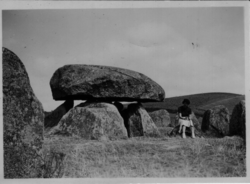Poskær Stenhus
| The Poskær Round Barrow in Denmark | |
|---|---|
|
23 man-high slabs are placed in a circle around the Poskær central dolmen. | |
 Poskær is located on the peninsula, Djursland in Denmark, close to the entrance to The Baltic Sea between Denmark and Sweden. | |
| Location | Syddjurs Municipality |
| Nearest city | Ebeltoft |
| Coordinates | 56°13′26.88″N 10°30′45.15″E / 56.2241333°N 10.5125417°ECoordinates: 56°13′26.88″N 10°30′45.15″E / 56.2241333°N 10.5125417°E |
Poskær Stenhus is the largest round barrow in Denmark, dating back to 3.300 B.C., located by the village Knebel on the hilly southern part of the peninsula, Djursland, at the entrance to The Baltic Sea between Denmark and Sweden in Northern Europe.[1] The central burial chamber is equipped with a capstone weighing 11 tonnes, surrounded by 23 slabs taller than a man, forming a circle.[1]

The capstone is the lesser half of a granite slab brought to Denmark from Northern Scandinavia by ice age glaciser movements. The underside is remarkably flat, and possibly split from an other half, by the dolmen builders. The other half is a 19-ton slab located two km to the northwest, placed as a capstone on an other dolmen, Agri Dyssen.[1] How these slabs were transported and erected by stone age people is open to interpretation.
Apart from Denmarks eastern-most island, Bornholm, the country has no bedrock. Therefore, large granite slabs have been sought out for construction purposes through the times. For this reason a lot of dolmens have disappeared or been damaged.[2]

In 1859 a landowner, Ole Hansen, attempted to dynamite slabs from Poskær Stenhus. A local priest started a process to stop the destruction of the burial site, ending with an official protection of the site in 1860. As part of this Ole Hansen was given a compensation of 100 rigsdaler.[2] A broken slab-part with drill-marks from dynamiting (see picture) at the barrow gives witness to his endeavor. At least one slab was destroyed before the site was protected.
|
Literature
- Palle Eriksen, Poskær Stenhus – myter og virkelighed, Moesgård Museum, 1999. ISBN 87-87334-34-8.
References
External links
| Wikimedia Commons has media related to Poskær Stenhus. |
- Poskær Stenhus – Danmarks største runddysse – Nationalpark Mols Bjerge
- Poskær Stenhus, Reddet fra sprængstof – 1001 fortællinger om Danmark

